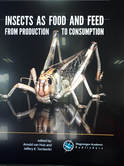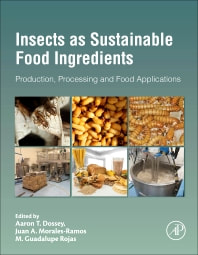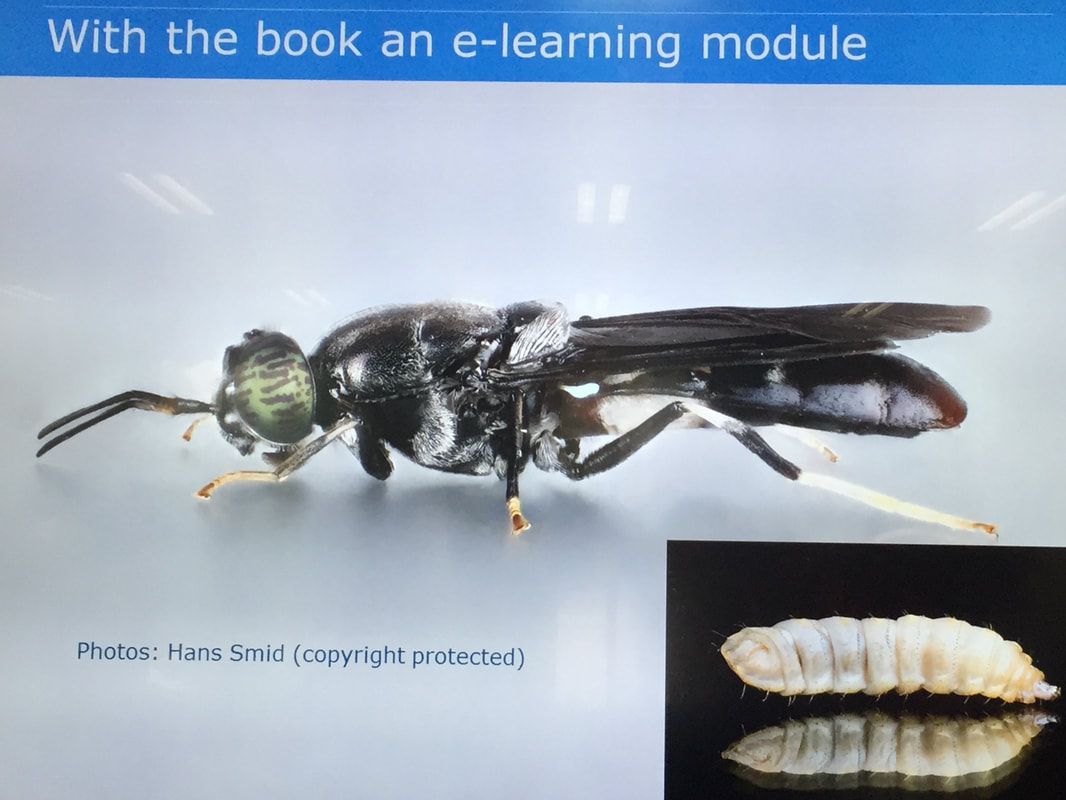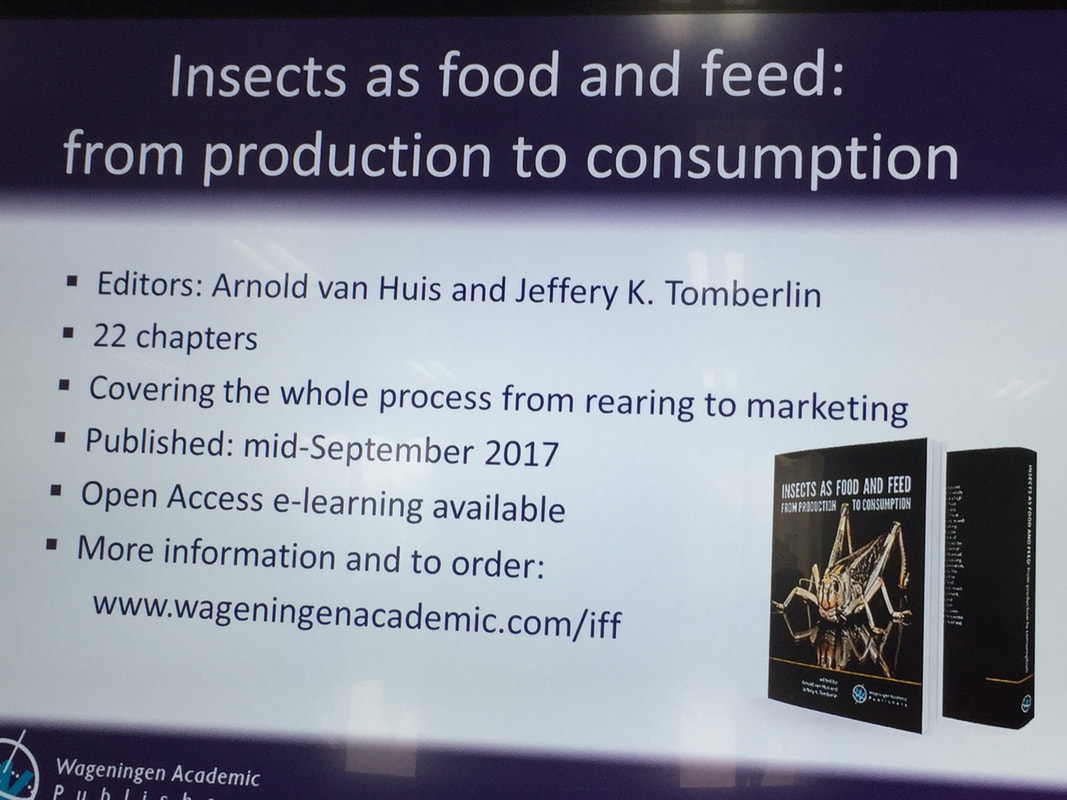|
I thought I would be fun to reach out to everyone in "real-time" through twitter. So- if you want to keep up with info on BSF and beyond in relations to decomposition ecology... my handle is: @FliesFacility Best of luck and happy BSF farming!! AuthorJeff Tomberlin, PhD, bringing BSF to twitter
2 Comments
 Here is the third book on insect farming. This book has some pretty cool features associated with it. First, it has an interactive platform available online. Through this platform you can see some amazing 360 degree images of insects (such as the BSF below), videos, as well as test your knowledge through the quiz sections. I must admit- I like this book a lot... but then again, I am an editor on it (many thanks to Arnold van Huis for the invitation to help lead this charge). I hope you enjoy it too. Link to book: www.wageningenacademic.com/doi/book/10.3920/978-90-8686-849-0 I hope this information is helpful. And best of luck moving foward and happy BSF farming!! AuthorJeff Tomberlin, PhD, BSF author  The second text I am providing here is another great step forward in providing resources for those interested in insect farming. I personally had the opportunity to contribute to this one- BSF production of course. This text is exceptional in terms of depth of knowledge brought into a single location- a great resource for sure! Here is the link: www.elsevier.com/books/insects-as-sustainable-food-ingredients/dossey/978-0-12-802856-8 Great job, Aaron Dossey, Juan Morales-Ramso, & M. Guadalupe! As always- I hope this information is helpful! Bbest of luck moving forward and happy BSF farming! AuthorJeff Tomberlin, PhD, BSF author I thought I would share these books with you- at least the three I am aware of that relate to insect farming as a means for mass production. The first book I am describing here is probably the most widely distributed (2.3 million downloads) and is available in different languages than english- including Chinese (even though that wasn't by plan from what I gather). This book is entitled, "Edible Insects: Future Prospects for Food & Feed Security" by Professor Arnold van Huis. Here is Arnold's website at Wageningen University in the Netherlands: www.wur.nl/en/Persons/Arnold-van-Huis-1.htm I have known Arnold for a few years. And, I am actually with him in China now. Class act- great to be around and learn about insects as food and feed. And- here is the link for the book: www.fao.org/docrep/018/i3253e/i3253e.pdf This book is great for learning about the need for insect farming and what it could mean to the world. As I am sure you all are aware, traditional livestock production isn't the most economical, especially when you consider that we have a limited amount of space for the animals or the resources (e.g., feed) needed to support them. Of course, the BSF is a key species that is revolutionizing the insect-farming industry. As always, I hope this information is useful. Until next time best of luck and happy BSF farming! AuthorJeff Tomberlin, PhD, BSF wrangler So, as I sit here in Wuhan, China (after another delicious meal that has left me in a state of gastric nirvana), I have had a few minutes to reflect on the question- what issues do I think are most challenging for anyone involved in black soldier fly production? And, while there are many....believe me... many... one issue I thought I would tackle in this post is the idea of self-identification.... not you identifying with whom you are and how you function... but about your black soldier fly and how it compares to other black soldier fly populations either in the same town (yes, even populations in the same town can be drastically different from one another)....state....province....nation...hemisphere... and possibly planet one day (think space exploration). Well, a few years ago I had a chance to conduct a study with some colleagues in China that sorta addressed this issue. At minimum- it demonstrated my point which is emphasized in this post. Here is the citation for the paper. Zhou, F., J. K. Tomberlin, L. Zheng, Z. Yu, and J. Zhang. 2013. Developmental and waste reduction plasticity of three black soldier fly strains (Diptera: Stratiomyidae) raised on different livestock manures. Journal of Medical Entomology 50: 1224-1230. The basic premise for the study was to compare different populations from various regions of China and one population from the USA in terms of how they digested various wastes (e.g., conversion rates, turnover, etc) and how those wastes impacted their development and production. What we found was pretty cool for the BSF community- but not surprising. These populations differed dramatically. Some populations were better at digesting poultry waste while others were better at digesting swine manure. In addition, these populations responded differently in terms of how they developed and survived on these waste streams. Here is the link to the paper if you would like to read it: www.bioone.org/doi/abs/10.1603/ME13021 So what does it all mean? Well- the main point to this discussion is to suggest that you have some flexibility (exercise some caution) when reading results that someone else has generated as they might not translate to your population. You will need to determine what works best for your BSF population. What should you do? The easiest thing to do is to keep records of what you feed your BSF larvae and what you produce (amount of larvae). Now, keep in mind, production will depend on how many larvae are in the bin in combination with environmental conditions (temp, humidity, light cycle) and food waste type to name a few. But, if you have some ideas of what produces the most larvae while recycling waste the best- stick with it. Avoid those things that cause larval die-off. But of course- continue to experiment on the side- maybe with a different unit. What does this mean with regards to reading and applying information posted by others (I need to stick to the point, right)? Again, like I mentioned before- be flexible with how you approach your system and apply information you read online. Flexibility goes a long ways towards sustainable production of BFS. I hope this information is useful. And until next time, best of luck and happy BSF farming!! AuthorJeff Tomberlin, PhD, BSF wrangler What does it matter if I overfeed? Overfeeding is bad news waiting to happen!! This is extremely important to avoid other pests becoming established (see previous point) or the outbreak of disease. Yes - the BSF are susceptible to certain microbes. While they haven't been identified yet (some speculate bacteria- others think fungi), the pathogen often occurs in over fed larvae. Infected larvae swell up like balloons and die. They also exhibit a behavior of aggregating at the top of the waste but not feeding. Now- this is very important, the pathogen, whatever it is, is highly transferrable. If you have multiple bins- DO NOT touch an infected bin and then touch an uninfected bin. You run the risk of transferring the infection. Also, if you have an infected bin- you will want to empty it quickly and sterilize/clean as best you can. Using a 10% bleach solution and allowing to air dry in direct sunlight will help. The issue is if your bin is made of wood which might be more challenging to clean. I hope this information helps you be successful- but please let me know if there are specific topics you would like covered. We are here to help. Until my next post- best of luck and happy black soldier fly farming!! AuthorJeff Tomberlin, PhD, BSF ecologist When do I feed the larvae? Try to avoid over-feeding the larvae. If you see 30-50% of the food your provided initially still present, you might want to delay introducing more feed. Doing so will allow the larvae to fully digest the waste so space is optimize (not filling the bin with waste that hasn't been digested) and enhance larval growth as they can work as a group finishing partially digested material (easier for them to breakdown rather than fresh meats and veg). But so what? who cares if I over feed the larvae, you might be asking....glad you asked that question. I hope this information helps you be successful- but please let me know if there are specific topics you would like covered. We are here to help. Until my next post- best of luck and happy black soldier fly farming!! AuthorJeff Tomberlin, PhD, BSF ecologist Where do I place the feed? Where you place the feed in your bin will greatly impact turnover of the waste and BSF larval production. You definitely do not want to place a heaping mound of waste in the center of your bin. Doing so will result in the waste rotting before the BSF larvae can access it. Also- you run the risk of other flies (e.g., house flies, blow flies) colonizing the waste resulting in a issue for you, your pets as well as your neighbors. So, to avoid this issue, try to apply a thin layer of waste (2-4 inches) deep on top of the compost containing the larvae. Don't worry, the larvae will find it and digest it. If you see waste still on the surface... well- that's another issue (see subsequent post). I hope this information helps you be successful- but please let me know if there are specific topics you would like covered. We are here to help. Until my next post- best of luck and happy black soldier fly farming!! AuthorJeff Tomberlin, PhD, BSF ecologist Larval nutrition- Okay... so what do you feed the larvae? The good news is black soldier fly larvae can handle just about anything that isn't boiling hot, void of nutrition (cardboard), or frozen. But there is a balance. As a FYI- we are planning a future blog post (as previously mentioned) that will go into more detail on larval nutrition. But for here- one thing you should know is while BSF larvae are omnivorous, they do better on plant-based material (veggies). If you plan to feed them meat, it should be, 1) shredded to increase accessibility by the larvae (don't place a pork roast in the bin whole and expect the larvae to digest it quickly), 2) mixed with other materials that can allow larvae to access nutrients quickly (maybe think along the lines of 40:60 mix with veggies being the primary component). In the end, if done correctly, larvae should be high in protein (40% or more) and fat (30%). Oh! One other thing- avoid highly acidic material. While the larvae can work the material and digest it, they are challenged and will exert a lot of energy to bring it to a more neutral pH. I hope this information helps you be successful- but please let me know if there are specific topics you would like covered. We are here to help. Until my next post- best of luck and happy black soldier fly farming!! AuthorJeff Tomberlin, PhD, BSF ecologist When I think about producing black soldier fly (BSF) larvae, one of the greatest challenges encountered is determining what is best to feed them so that I get optimal BSF larval production and individual size (it does matter). You have to remember that BSF larvae grow from less than 0.01 g to potentially 0.5 g. So, what you feed them early will impact if they survive and what they become. So, for this post, I will break down the discussion into two parts; 1) particle size of larval feed over time (as larvae grow, 2) impact of nutrition (will be discussed in more detail in future blog posts), 3) where to feed them, and 4) when to feed them. Particle size- one thing I have noticed when viewing images of food waste being provided larvae is that in many cases the feed is actual human quality food. I can tell from the images that carrots, potatoes, and spinach are being provided... in their whole form. When working with BSF larvae, you want to avoid feeding them whole foods- you might consider breaking it up a bit. Maybe, if time permits, you might consider shredding it. Now, I don't want to create more work for you than is necessary as the process should be simple and easy to apply. So, at minimum, just break it up with your hands. The smallest he pieces of food, the easier it is for them to access the nutrients (surface area v. volume). Think of it like with your children (if you have any)- you don't give them a hamburger as their first meal. You give them food specifically for babies- something easily digested... something that is actually a paste. As they get older (the larvae), they can manage larger food fragments. By following these instructions, you should be able to get larvae to grow faster and with less mortality. But what if I have mixed larvae (young and old)? Good question, I am glad you asked. You can go with larger feed size as the big larvae will fragment the food waste and make nutrients available for the smaller larvae. I hope this information helps you be successful- but please let me know if there are specific topics you would like covered. We are here to help. Until my next post- best of luck and happy black soldier fly farming!! AuthorJeffery K. Tomberlin, PhD, BSF ecologists |
AuthorIndividuals with over 25 years research experience with the black soldier fly. We are passionate about the science behind the black soldier fly and its ability to convert waste to protein. Get Notified Here
Archives
September 2022
Categories
All
Install an RSS app to get notified from us when a new post is up!
|
ServicesSupport |
About |



 RSS Feed
RSS Feed

